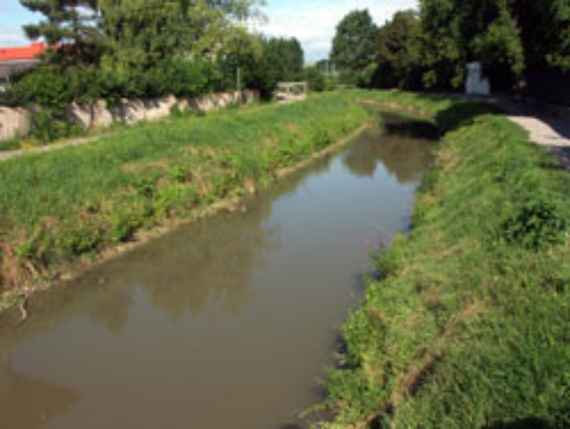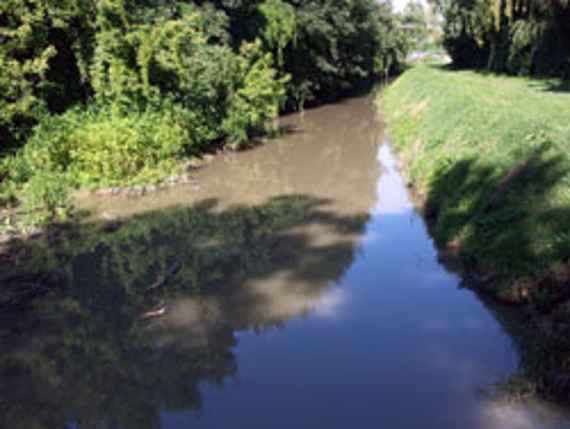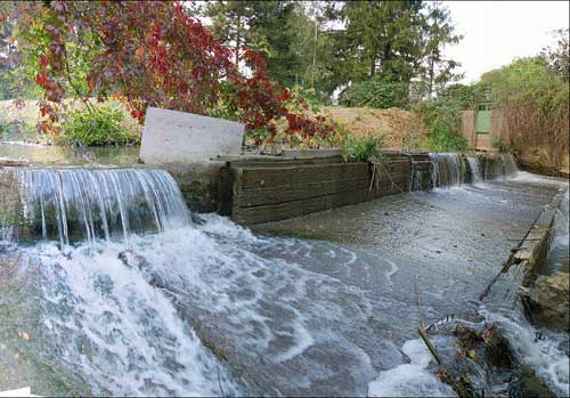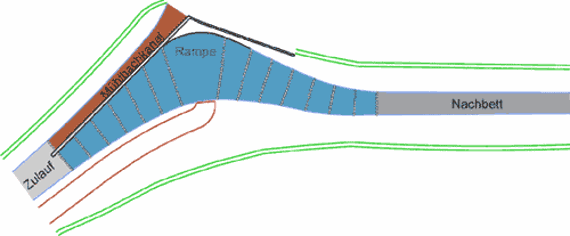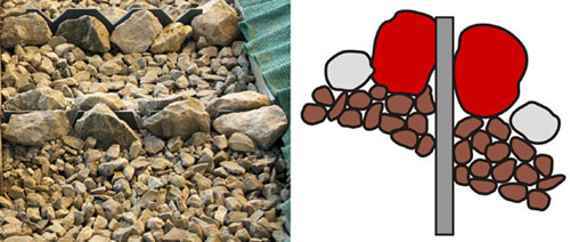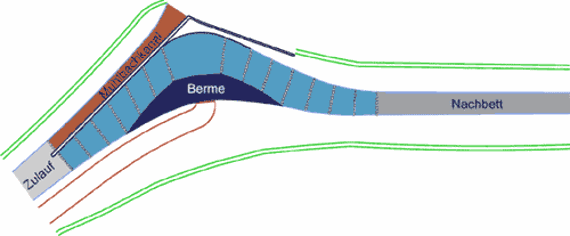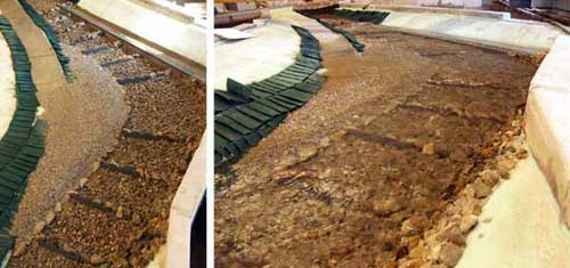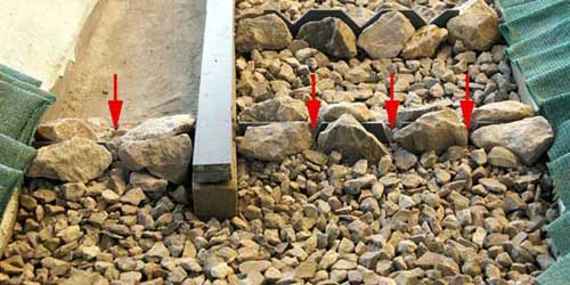Due to the impact of the rainfall events in March 2004, the weir system of the Russbach-Muehlbach weir in the municipality of Wolkersdorf was damaged and partially breached. As a result, the stability of the structure is massively endangered. In a physical model test the weir structure was replaced by a flatly inclined, structured ramp and tested with regard to its stability and hydraulic effect.
CUSTOMER: Office of the Lower Austrian Provincial Government, Department of Hydraulic Engineering, Regional Office Weinviertel
Cooperation partners: Ecological Station Waldviertel of the Federal Office for Water Management, Team Kernstock ZT GmbH for Civil Engineering and Water Management (Internet: www.kernstock-zt.at)
The Russbach is a typical watercourse of the Weinviertel and runs for the most part in loess. The subsoil conditions therefore differ significantly from waters in other regions in Austria, where coarser material from gravel in rivers to large stones and blocks in torrents dominate.
Russbach in Wolkersdorf upstream oft the weir
Russbach downstream of the weir
Partially destroyed weir
In order to prevent the complete destruction of the structure by another flood event and also to restore the continuity of the river for fish, it was decided to replace the weir by a flatly inclined, structured ramp with a slope of 2 %. The conversion of the old weir was already planned by the Kernstock office. Due to the location of the weir in a curve and the resulting uneven loading including highly complex three-dimensional flow conditions, the planning was checked in a hydraulic model test, as the design approaches used in the planning only apply to straight ramp structures. Special attention was paid to the securing of the bed in the basins between the single stone-bars of the ramp and the link of the structure with the downstream watercourse, in order to take into account the special subsoil conditions in the loess.
Ground plan of the structured ramp in the river bend (flow from left to right)
For the model a scale of 1 to 12 was chosen. Within the scope of the model tests, special attention was paid to the following points:
- Stability of the planned structure, construction of the ramp (bar and basin stone sizes, downstream bed protection, layer structure, number of stones in the basins) as well as optimization of the material requirements
- observation of the currents at low flow conditions (ecological continuity) and optimization of the migration corridors
- Flow splitting ratio between Russbach and Muehlbach for an optimal supply of the castle pond with water
Stability of the structure
Even if the structure is a special case due to the curve situation, basic knowledge can still be gained for structured ramps with greater heights in loess soils. The height difference between the ramp crown and the bed downstream is about 1.3 m according to the planning of the Kernstock office. Special attention has to be paid to the securing of the bed between the individual bars and the integration of the structure in the underwater.
Layer structure of the ramp body
Translate from German to English:
Steinbelegung (Riegel-/Beckensteine) = stone allocation (crossbar/basin stones)
Filterschicht = filter layer
Vlies = fleece
Untergrund - Löss = subsoil - loess
The bars consisted of 1-2 rows of stones, depending on the location of the bar on the ramp. The more heavily loaded bars in the upper, narrow area of the ramp were constructed with 2 rows of stones each. The pools were constructed with an occupancy density of between 30 and 70 %, whereby the pools in the upper area of the ramp again had the higher occupancy densities. The downstream bed protection was designed trough-shaped with a total length of 50 % of the ramp length in order to reduce the energy conversion at the foot of the ramp and thus the surface waves downstream. In addition, the downstream bed protection was constructed in the same way as the basins of the ramp, with a fleece at the bottom, a filter layer and a stone layer with 20 % occupancy density.
Ecological continuity
In the course of the model tests, it became apparent that a special design of the bars is required to restore the passability, especially in the case of low water. Therefore, a row of wooden bars was placed between or in front of the bar stones, into which controlled migration corridors can be cut, through which the low-water runoff flows off. Furthermore, the large width of the watercourse in the area of the curve was reduced to a width of about 5-6 m by a berm at the inner watercourse bend. This also improves the low water discharge as well as the material requirements for the construction of the berm and has only a marginal influence on the flood discharge.
Bar design with central row of wooden bars to improve the ecological continuity
Ground plan of the optimized ramp with berm on the right bank (flow from left to right)
Right-hand berm and discharge at HQ1 (both viewed against direction of flow)
Water supply of the Muehlbach Canal
The requirement of flow distribution ratio of 1 to 3 between the Muehlbach Canal and the Russbach for low discharges was ensured analogous to ecological continuity, by the arrangement of a row of wooden bars with clearly defined hiking corridors (3 on the side of the Russbach, 1 on the side of the Mühlbach Canal). With a corresponding number of flow openings in the wooden bar in the Russbach or Muehlbachkanal, the wooden bar row serves as a flow control with corresponding flow distribution until it is completely overflowed.
Design of the uppermost bar with clearly defined flow openings (hiking corridors) to create the required flow distribution ratio of 1 to 3 between Muehlbachkanal and Russbach

